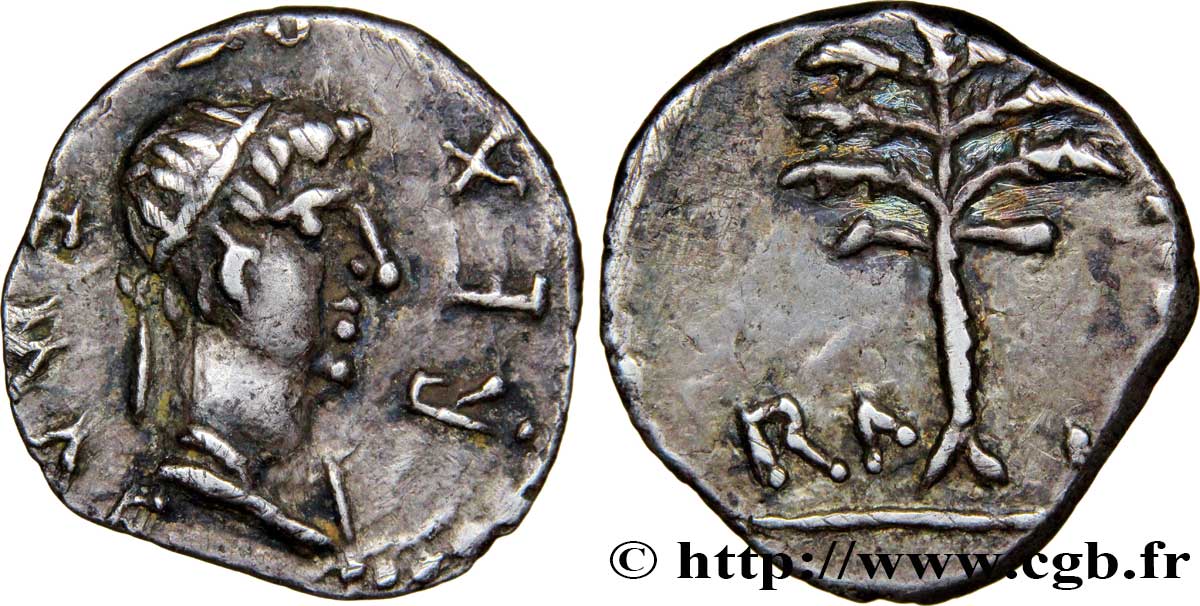v61_0046 - MAURETANIA - REINO DE MAURETANIA - PTOLEMEO Denier
MONNAIES 61 (2014)
Precio de inicio : 750.00 €
Valoración : 1 200.00 €
Precio realizado : 790.00 €
Número de ofertas : 2
Oferta más alta : 800.00 €
Precio de inicio : 750.00 €
Valoración : 1 200.00 €
Precio realizado : 790.00 €
Número de ofertas : 2
Oferta más alta : 800.00 €
Tipo : Denier
Fecha: an 1
Nombre del taller / ciudad: Césarée, Maurétanie
Metal: plata
Diámetro: 14 mm
Eje de acuñación: 1 h.
Peso: 1,68 g.
Grado de rareza: R3
Comentarios sobre el estado de conservación:
Exemplaire sur un petit ovale et irrégulier, court sur les légendes. Beau portrait de Ptolémée. Joli revers bien venu à la frappe. Belle patine de collection ancienne avec des reflets dorés
N° en los catálogos de referencia :
Anverso
Titulatura del anverso: REX - [PTOLEMAEVS].
Descripción del anverso: Buste diadémé et drapé de Ptolémée à droite, (A’01).
Traducción del anverso: “Rex Ptolemaeus”, (roi Ptolémée).
Reverso
Titulatura del reverso: R A - I.
Descripción del reverso: Palmier.
Traducción del reverso: (règne an 6).
Comentario
Poids très léger. Normalement, Ptolémée a succédé à son père Juba Ier en 23. Mais en fait, il est associé aux affaires depuis 20 après J.-C. La datation des années régnales devrait donc se faire à partir de cette date. Ce type semble beaucoup plus rare que ne le laissent supposer les ouvrages généraux. Sur cet exemplaire l’année régnale est difficile à interpréter. C’est normalement l’an I (20-21) mais le flan est court et le type est aussi connu pour l’an 2 (A. 251).
Very light weight. Normally Ptolemy succeeded his father Juba I in 23. But in fact he has been associated with affairs since 20 AD. The dating of the regnal years should therefore be done from this date. This type seems much rarer than general works suggest. On this example the regnal year is difficult to interpret. It is normally the year I (20-21) but the flan is short and the type is also known for the year 2 (A. 251)
Very light weight. Normally Ptolemy succeeded his father Juba I in 23. But in fact he has been associated with affairs since 20 AD. The dating of the regnal years should therefore be done from this date. This type seems much rarer than general works suggest. On this example the regnal year is difficult to interpret. It is normally the year I (20-21) but the flan is short and the type is also known for the year 2 (A. 251)








 Informar de un error
Informar de un error Imprimir la página
Imprimir la página Comparte mi selección
Comparte mi selección Haz una pregunta
Haz una pregunta Consignar / vender
Consignar / vender





